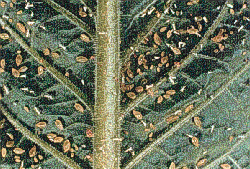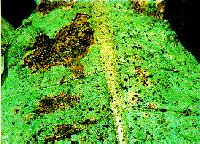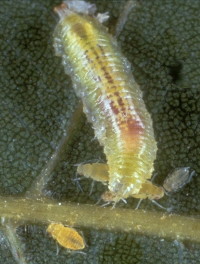Aphids
ENTFACT-103: Aphids | Download PDF
by Lee Townsend, Extension Entomologist
University of Kentucky College of Agriculture

Aphid Infestation
Aphids are soft-bodied insects that use their piercing sucking mouthparts to feed on plant sap. They usually occur in colonies on the undersides of tender terminal growth. Heavily-infested leaves can wilt or turn yellow because of excessive sap removal. While the plant may look bad, aphid feeding generally will not seriously harm healthy, established trees and shrubs.
However, some plants are very sensitive to feeding by certain aphid species. Saliva injected into plants by these aphids may cause leaves to pucker or to become severely distorted, even if only a few aphids are present. Also, aphid feeding on flower buds and fruit can cause malformed flowers or fruit.

Sooty Mold
Aphids produce large amounts of a sugary liquid waste called "honeydew". The honeydew that drops from these insects can spot the windows and finish of cars parked under infested trees. A fungus called sooty mold can grow on honeydew deposits that accumulate on leaves and branches, turning them black. The appearance of sooty mold on plants may be the first time that an aphid infestation is noticed. The drops can attract other insects such as ants, that will feed on the sticky deposits.
Some aphids are very important vectors of plant viruses. However, it is seldom possible to control these diseases by attempting to kill the aphid vectors with an insecticide. Aphids carrying viruses on their mouthparts may have to probe for only a few seconds or minutes before the plant is infected. Resistant varieties or sequential plantings may be helpful in reducing problems with some viruses that attack annual plants.
HOW THE PROBLEM STARTS
Infestations generally result from small numbers of winged aphids that fly to the plant and find it to be a suitable host. They deposit several wingless young on the most tender tissue before moving on to find a new plant. The immature aphids or nymphs that are left behind feed on plant sap and increase gradually in size. They mature in 7 to 10 days and then are ready to produce live young. Usually, all of them are females and each is capable of producing 40 to 60 offspring. The process is repeated several times, resulting in a tremendous population explosions. Less than a dozen aphid "colonizers" can produce hundreds to thousands of aphids on a plant in a few weeks. Aphid numbers can build until conditions are so crowded, or the plant is so stressed, that winged forms are produced. These winged forms fly off in search of new hosts and the process is repeated.
CONTROL
Early detection is the key to reducing aphid infestations. The flight of winged colonizers cannot be predicted, so weekly examination of plants will help to determine the need for control. Examine the bud area and undersides of the new leaves for clusters or colonies of small aphids. The presence of these colonies indicates that the aphids are established on the plants and their numbers will begin to increase rapidly. Small numbers of individual colonies on small plants can be crushed by hand or removed by pruning as they are found. In some cases, this may provide adequate control. If aphid colonies can be found on about 5% or more of foliage tips of a plant or planting, then a control measure should be considered. Most products used for aphid control work as contact insecticides. This means that the aphids must be hit directly with spray droplets so that they can be absorbed into the insect's body. Since aphids tend to remain on the lower leaf surface, they are protected by plant foliage. Thorough coverage, directed at growing points and protected areas, is important. It is difficult to treat large trees because of the high spray pressure necessary to penetrate the foliage and to reach the tallest portions of the tree. Hose-end sprayers can be used on 15 foot to 20 foot trees but they need to produce a stream rather than an even pattern to reach these levels. Skips in coverage are common and there is a significant potential for applicator exposure through drift and runoff. Commercial applicators may have the necessary equipment but these treatments may be very expensive. Aphid control is rarely feasible in these situations.
Summer oils can be used against aphids on some types of trees and ornamental plantings. They kill by suffocating the insects and/or disrupting their membranes. Check the label for cautions on sensitive plants; oils can injure the foliage of some plants. Weather conditions, especially high temperatures, can increase the potential for foliage burn. Do not spray dormant oils during the growing season. There is no residual effect so additional applications may be necessary.
Fatty acid salts or insecticidal soaps are very good against aphids. As with summer oils, they apparently work to disrupt insect cell membranes. They require direct contact with the insects and leave no residual effect.
Nervous system insecticides, such as malathion, Dursban (chlorpyrifos), and Orthene (acephate), are labeled for use on many shade trees and ornamental plants for aphid control. As with oils and soaps, coverage is very important and a follow-up application may be necessary. Be sure that the plant or crop that you are treating is listed on the product label. Sevin (carbaryl) is not effective against many aphids so it is generally not a good choice for control unless recommended specifically. In fact, applications of Sevin may reduce the number of beneficial insects, such as lady beetles, and increase the potential for aphid outbreaks.
WHAT HAPPENS IF NOTHING IS DONE?
Aphid control is most valuable for new plantings, where excessive sap removal is more likely to affect general plant vigor. Established and otherwise healthy plants can tolerate moderate to heavy aphid infestations, although affected leaves may wilt and turn yellow and there may be some premature drop.
Good cultural practices, such as watering and fertilization, will help to reduce stress by these insects. Problems with honeydew and sooty mold may develop but tend to be temporary and disappear after the aphids are gone.
A few aphid species produce cupped or distorted leaves; these plants may lose some of their esthetic appeal for the season. Once the distortion occurs, the leaves will remain cupped and twisted until they fall off. Usually, the infestation is not noticed until the injury has occurred. Insecticide applications often are less effective because the aphids are protected in the gnarled leaves.
Plants that become infected with an aphid-borne virus may be severely stunted and may die. Preventive sprays are rarely effective in keeping viruses out of plantings but they may reduce the spread within a group of susceptible plants.
NATURAL ENEMIES

Syrphid Fly Larva: an important aphid predator
Beneficial insects, such as lady beetles and lacewings, will begin to appear on plants with moderate to heavy aphid infestations. They may eat large numbers of aphids but the reproductive capability of aphids is so great that the impact of the natural enemies may not be enough keep these insects at or below acceptable levels.
Revised: 1/00
CAUTION! Pesticide recommendations in this publication are registered for use in Kentucky, USA ONLY! The use of some products may not be legal in your state or country. Please check with your local county agent or regulatory official before using any pesticide mentioned in this publication.
Of course, ALWAYS READ AND FOLLOW LABEL DIRECTIONS FOR SAFE USE OF ANY PESTICIDE!
Photos courtesy USDA Insect and Plant Disease Slide Set and University of Kentucky Entomology
